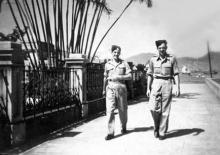02 Oct 1941, Chronology of Events Related to Stanley Civilian Internment Camp
Primary tabs
Today is a fateful day for 2,000 young Canadians and their families: Prime Minister Mackenzie King and his cabinet make the final decision to send the Winnipeg Grenadiers and the Royal Rifles of Canada to reinforce Hong Kong. They'll leave Vancouver on October 27 and arrive in Hong Kong on November 16. They will become the first Canadians to see action in WW11 and the 1400 or so who survive will endure the dreadful conditions of Shamshuipo, Argyle Street and the Japanese labour camps.
Why did the Canadians get sent to Hong Kong? A New Theory
David Macri, in Clash of Empires in South China (2012) has put forward a remarkable but carefully documented theory as to why the Canadians were sent to take part in an apparently hopeless defence. The salient points of his thesis are:
1 The troops were not sent, as had previously been assumed, as part of a commitment to the defence of the British Empire (282);
2 The context for the decision to send them was the desperate struggle of the Soviet Union against the three invading German army groups in the autumn of 1941 (272-275);
3 The nightmare scenario for the British and Americans was that Chinese resistance to the Japanese would collapse and that this would in its turn bring about a failure of Russian will to continue the fight - or even a direct Japanese assault on mineral-rich Siberia (277);
4 The Canadians were sent to show Chiang Kai-shek that the British were determined to mount a serious defence of Hong Kong and thus stiffen his resolve and prevent him from making peace with the Japanese - but the real recipient of the message was Josef Stalin, who would be encouraged by a firm British defence policy in the East, and in particular support for his Chinese ally, to continue his fight with the Germans (11, 282-283);
5 Although the British were in complete agreement with this policy, the real movers behind it were the Americans - in general Canada was by now more allied to the USA than to Britain and its Empire, and Macri claims that 'Canada's policy of military intervention in China originated inside the White House' (11, 279);
6 The Canadians were not sent to deter the Japanese - in fact, Macri describes them as a 'provocation' - as both America and Britain had reasons for wanting the Japanese to be seen to begin a war they expected or even wanted (272, 279);
7 In the event of American public opinion needing to be convinced of the necessity to commit troops to Asia, a heroic defence of Hong Kong and one involving the shedding of Canadian blood would have great propaganda value (279).
This is, to put it mildly, a radical over-turning of the usual view that the October-November reinforcement was all about the defence of the Empire, whether seen as a legitimate or unjustifiable use of the lives of young Canadians. I'm not sure that all of the points above are consistent with one another - for example, if the aim was to avoid a Japanese thrust northwards from China into Russia, then why strengthen the defences to the south, which was the obvious alternative route for an attack? But international strategy can't always be consistent because so many variables are always in play, and Macri's grasp of various 'big pictures' is impressive. Further, his detailed account of the role played by Hong Kong in assisting the Chinese war effort in the south should explode once and for all the myth that the Colony was 'a sleepy British imperial outpost' (7) in the years before the Japanse attack.* Anyone interested in Hong Kong's pre-war and wartime history should know about this book and its ideas.
* I've attempted to put an end to this myth from a different perspective in three blog posts, the first of which is https://brianedgar.wordpress.com/2014/11/18/pre-war-hong-kong-the-myth-o...

